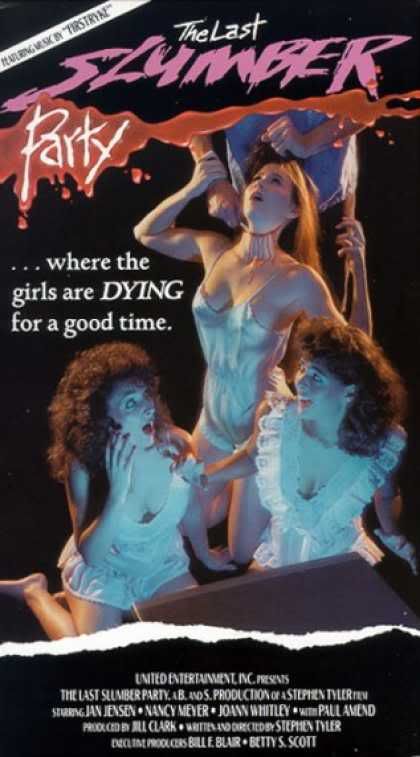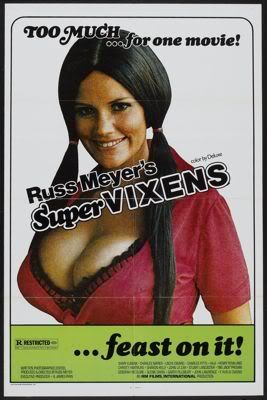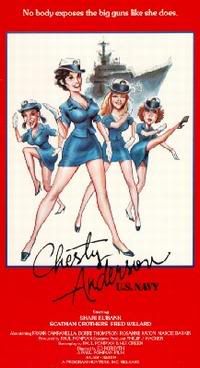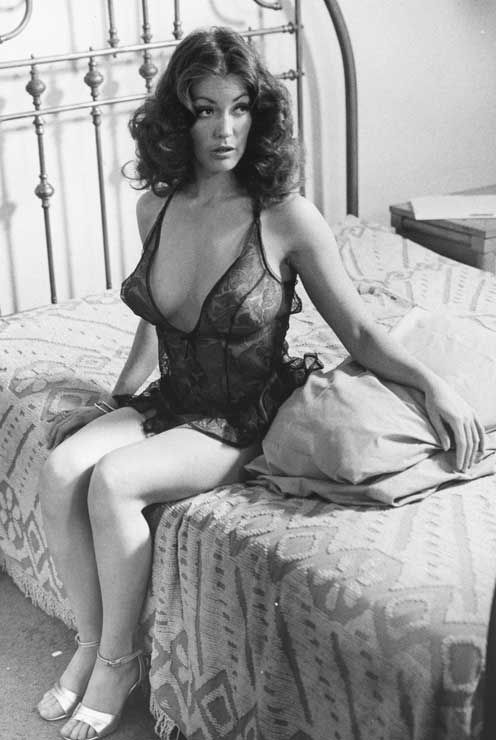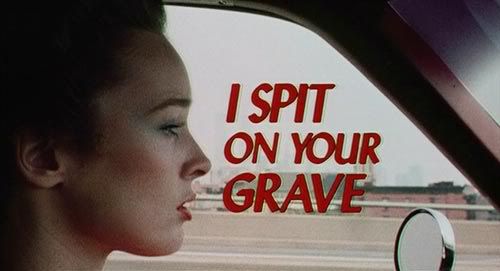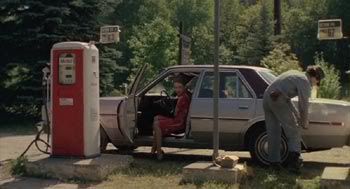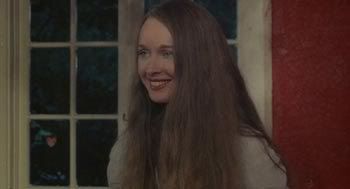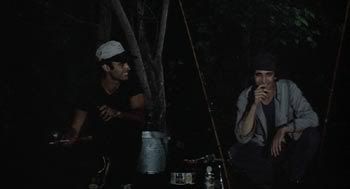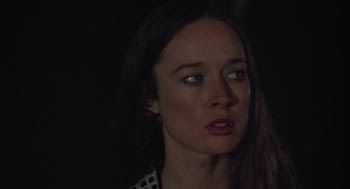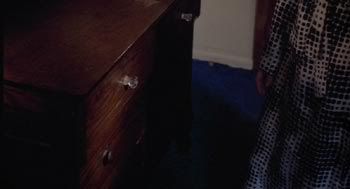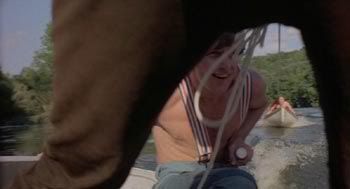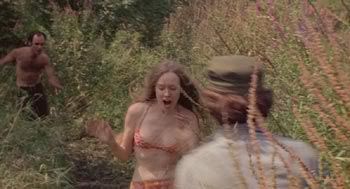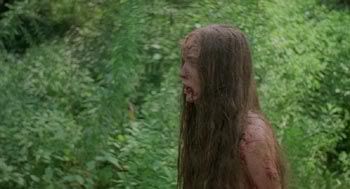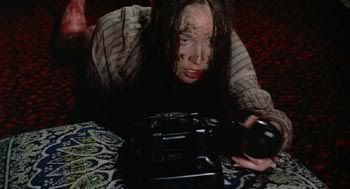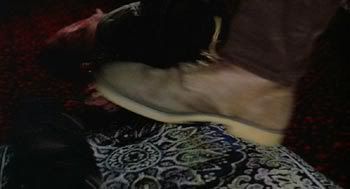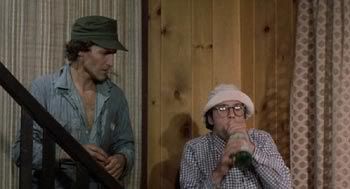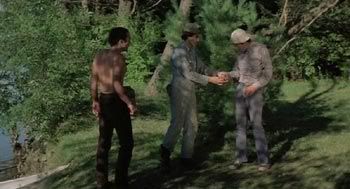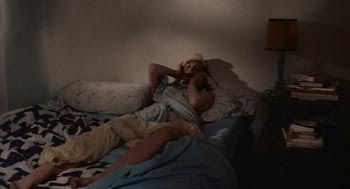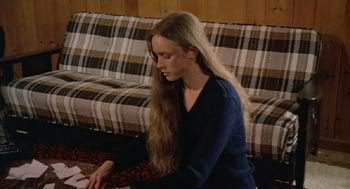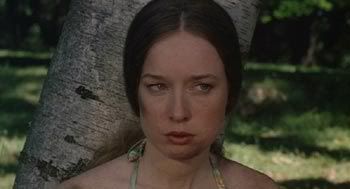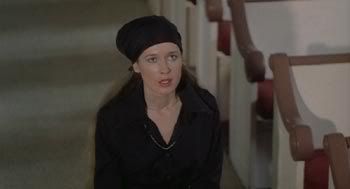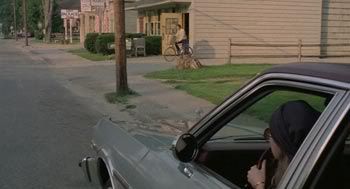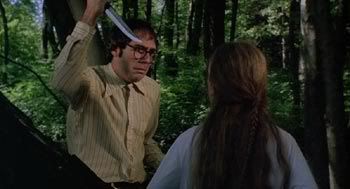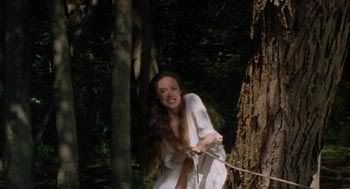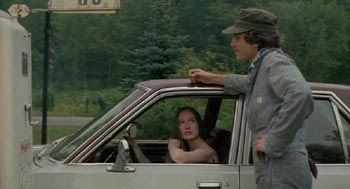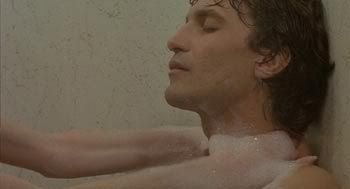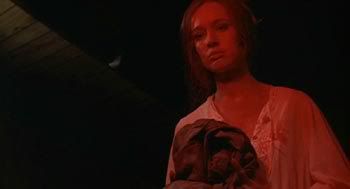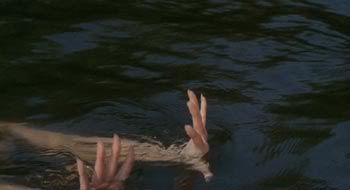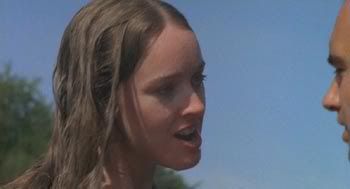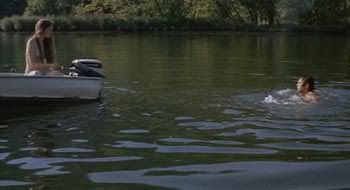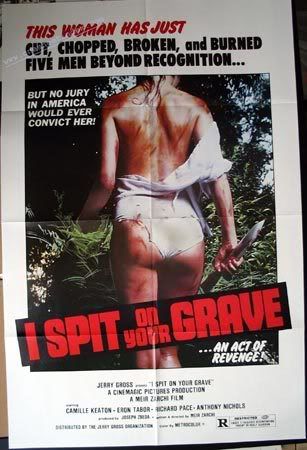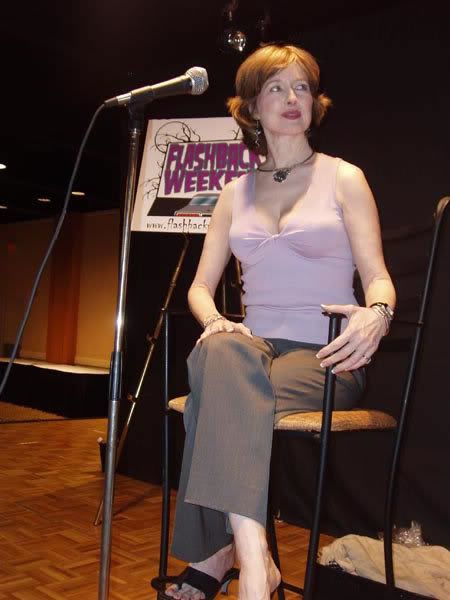It has been a long while since I last saw a film so insane I felt immediately compelled to document its madness in excruciating detail here at the H of G, but a few nights ago I decided on a whim to pop in a disk I’d been sitting on since I picked it up in a boxed set last December and…well…here we are.
I hope you’re comfortable, because I don’t think this is going to be brief.
I got about halfway through the movie before I started debating with myself over whether what I was watching was a What Were They Thinking Movie (WWTTM) or a Bad Film I Love Anyway (BFILA). At first I was convinced it was the former, given the film’s wildly disparate tone and combination of seemingly mutually exclusive elements, but as I continued watching it occurred to me that with a better script, the story being told could have made for an admittedly bizarre, but still genuinely good movie, which put it firmly in the latter category.
More than any other era in filmmaking, the 1980s provided us with the greatest number of what I like to call Conference Room Classics. These are films that are so overtly contrived to appeal to as many viewers as possible that you can actually hear in your head the boardroom discussion between a group of coked up movie executives that brought them into existence as you watch them. Today’s subject is an archetypal example of this lamentable and unheralded genre and here is just a small snippet of the conversation I imagined as I watched the movie:
Studio Executive #1: So, Douchebag, I hear you picked up the rights to an interesting new novel. Tell us about it.
Studio Executive #2: Thanks, Asshole! It’s a great idea with plenty of potential. It’s about this kid who’s a super-genius.
Studio Executive #3: I love it!Studio Executive #2: Hold on, Shit-for-brains! I haven’t even gotten to the good part yet. So the kid is such a super-genius, his best friend is an adorable artificially intelligent robot he built himself.
Studio Executive #1: Wow. I think I just came in my pants! That sounds just like that Steve Guttenberg movie TriStar is making. They say it’s going to be a big hit!
Studio Executive #4: This sounds great! We need a good family comedy on our slate.
Studio Executive #2: You didn’t let me finish Dickface! This isn’t a family comedy! It’s a horror movie!
Studio Executive #1, 3 & 4: SAY WHAT?
Studio Executive #2: Y’see the super-genius kid is new in town because he’s such a super-genius he’s already enrolled at the local college, and he falls in love with the cute blond girl who lives next door.
Studio Executive #4: I like cute blond girls. Cute blond girls are good,
Studio Executive #2: So they become really good friends and everything seems like it’s all going to be happy and stuff, but then the robot gets destroyed by the crazy woman who lives across the street and the girl gets killed by her abusive alcoholic father.
Studio Executive #3: That’s sad.
Studio Executive #2: But the kid is such a super-genius he figures out that he can bring his friend back to life by implanting the same microchip that powered his robot into her brain.
Studio Executive #1: That makes sense!
Studio Executive #2: The problem is that when the girl comes back to life, she’s like a robot and doesn’t have a…whatayacallit…y’know that thing that makes people feel bad about the stuff they do….
Studio Executive #1. 3 & 4: (Long silence)
Lowly Assistant: A conscience?
Studio Executive #2: That’s it, Lowly Assistant! You’re fired! Now, she doesn’t have a conscience, so she goes around killing the people who did her and the robot wrong.
Studio Executive #3: That’s so scary!
Studio Executive #1: I just came and shit in my pants at the same time! Really! I’ll show you if you’d like!
Studio Executive #4: It’s got everything! The kids will like the cute robot, the teenagers will like the gore and the adults will like the emphasis on higher education.
Studio Executive #2: So I take it you guys want to make it into a movie?
Studio Executive #1, 3 & 4: FUCK YEAH!
Studio Executive #2: Great. I think we can get the guy who made Nightmare on Elm Street to direct it.
And they did.
Today’s film not only earns the title of the Second Worst Wes Craven Movie of All Time (with it being just narrowly beaten out by The Hills Have Eyes Part II), but it also earns the award for the Second Worst Horror Movie Script Ever Written By A Future Oscar Winner (with Brian Helgeland’s 976-EVIL taking the top spot in this case).It is, as the above dialogue would suggest, an odd hybrid of a horror movie without a moment of tension or suspense and a fanciful children’s adventure that contains far too much violence and bad language to be in any way appropriate for a younger audience.
The popular term in Hollywood for this kind of failed combination is a Feathered Fish—named so because the poor creature can neither swim nor fly and merely lies there on the ground, satisfying neither of the potential diners for whose palates it has been bred. For most folks these poor creatures are best avoided at all costs, but to us gourmands of misbegotten cinema, they are tastier than the finest high-priced Russian caviar and by that standard, today’s subject is easily worth $1000 an ounce.
I am, of course, talking about:
Now before I spank Craven too hard for his second biggest filmic fiasco, I should acknowledge some of the background history that mitigates his failure, even if just a little. By the time he got around to making this, his eighth official feature film (he had also directed four TV movies by then), he had truly been put through the show business wringer.
His first (credited) film The Last House On the Left was an enormously profitable hit, but it was so controversial and alienating that it took him five years before he got his next gig directing The Hills Have Eyes. It too was a hit, but his follow-ups Deadly Blessing and Swamp Thing (a comic book adaptation seriously marred by budget difficulties) failed to make a mark at the box office. As a result he was unemployed for two years before he finally got the chance to direct his original screenplay A Nightmare On Elm Street. The result was one of the most important horror films of the 80s, but his deal with New Line Cinema kept him from financially capitalizing on its success. To add insult to injury, not only was he denied a piece of the enormous franchise he created, but was left to fend for himself when another screenwriter accused him of plagiarizing Nightmare and took him to court.
Broke and in desperate need of a job, he agreed to make The Hills Have Eyes Part II, but wasn’t given a big enough budget to produce a complete film—a problem he solved by having nearly half the film consist of flashbacks to the original. With the case against him finally dismissed, he remained in dire financial straits and eagerly accepted the next job that was offered him. In this case it was his first feature film for a major studio (his previous efforts having all been made by smaller independent companies), which meant that for the first time in his career he had an adequate budget to work with, but also meant that he now had to deal with a level of creative interference he had never experienced before. Unused to dealing with the petty demands of egotistical, coked-out executives, Craven lost control of the project and did his best to give the suits the movie they all seemed to so desperately want.
And that’s the film for which I am about to rip him a new one.
As for the film’s soon-to-be-heralded screenwriter, I can’t provide a similar defense since I’m not as well versed in the background of Bruce Joel Rubin. I do know that this was the first produced screenplay for which he got sole attribution (he received a story credit for Natalie Wood’s last film Brainstorm), but I cannot tell you if its incompetence on virtual every technical and creative level was the result of his being a relative neophyte, a lazy hack or his craven desperation to please the clearly misguided folks signing his paychecks. Whatever the case, his second produced screenplay, Ghost, won him an Oscar, while his third, Jacob’s Ladder, resulted in a genuine cinematic classic, so—if anything—what you are about to see does prove that in Hollywood it’s always possible to bounce back from anything, no matter how dire it may seem at the time. And believe you me, after this movie was released things must have seemed pretty damn dire.
Now let us get on with the petty sarcasm!
Staying true to what we are about to watch for the next 90 minutes, Craven and Rubin manage to present us with a logical blunder in the film's very first scene, even before the credits have been allowed to roll. The film starts with a thief breaking into a car parked in front of grocery store, so he can help himself to the cash found inside the wallet left conveniently on the driver side seat. But before he can make his getaway, he's stopped by a mechanical hand that appears from the back seat and grabs him firmly by the throat. When we're given a glimpse of this unseen vigilante's POV, it becomes clear that we are dealing with some sort of mechanical automaton and not a one-armed man with the coolest 80s era prosthetic limb of all time. The thief escapes from the vehicle without the money, just as our protagonist and his mother--the car's owner--walk out of the store, carrying their purchases.
What, you ask, is so illogical about this? Lemme answer you by asking a question of my own....
How did Mom pay for the groceries if her wallet was in the car?
Now I suppose a creative person could come up with a dozen answers to this question, but my experience as a hack writer knows that the only one that matters is: Who cares! We need the wallet to be in the car, so the thief has something to steal! Now, one could respond to this by asking why the thief couldn't just try and steal the car itself, but once again the hack writer in me already knows the response: The robot we built would never have been able to grab the actor's throat if he was sitting in the front seat, so we had to have him steal something he could pick up in a much more technically convenient position.
One of the misconceptions among non-creative folks is the idea that logical errors happen in movies because no one involved in the production was smart enough to point them out at the time.
Nothing could be further from the truth.
I would say that about 90% of the time, the author of a work can successfully name every single logical inconsistency that appears in their finished work--to the point that they are able to point out examples no one else would ever catch.
Why then don't they correct these mistakes?
Mostly it's pure laziness (you have to remember that most folks become writers to avoid ever having to do real work), but in a lot of cases it's a matter of resigned pragmatism. Often correcting a mistake causes more problems than it actually fixes and it's better to just ignore the blunder and hope no one makes too big a deal out of it. Unfortunately, we now live in a world filled with millions of assholes like me who take a twisted sort of delight in making exactly that sort of deal out of them. Hell, I've just spent two paragraphs discussing the movie's most minor error in logic!
What am I going to do when the shit really hits the fan?
Back to the movie, after our hero and his mom return to their car, we see them interacting together as they drive to their new home. It's immediately apparent that Paul Conway (Matthew Laborteaux) is a smart kid who has a loving, close relationship with his foxy mother, Jeannie (Anne Twomey). When they finally arrive at their destination we get to see just how smart he is when we see the mysterious backseat passenger exit from the vehicle.
A genuine prodigy, Paul has built his best friend, BB, all by himself--an achievement made all the more amazing by the robot's sophisticated artificial intelligence, which stands lightyears away from anything that exists even today, 22 years later.
Hey! This raises an interesting question!
Where the Hell did Paul get the money to build BB?
By 1986 the home computer movement was in full swing, but the market was still decades away from creating affordable hardware with the processing power needed to create a genuine artificial intelligence. When you consider that a remote-controlled puppet designed to merely create the illusion of such an achievement would have cost the production at least $100,000 (and probably closer to double that), it wouldn't be unreasonable to suggest that in 1986 dollars, BB would have been a $10,000,000 investment (including both hardware and labour).
Now, I know you're thinking I'm going to far. "It's called the willful suspension of disbelief, buttmunch!" I hear you mutter to yourselves as the glow from your computer screen slowly gives you a strange new cancer that hasn't been identified yet, but let me defend my nitpickiness by arguing that this is a film that takes all notions of credibility and shoots them in the back of the head so it can go back to their house and sodomize their crippled grandmother.
And it is for that reason that I feel no guilt as I focus on every little nit that I find to pick. More than anything else, the depiction of BB is what is responsible for the film's odd contradictory tone. All of the scenes featuring the robot attempt to recreate the moments of patronizing faux-hilarity that are familiar to anyone who grew-up watching films like Unidentified Flying Oddball on The Magical World of Walt Disney and they bear no relationship to the nightmarish imagery that follow them.
Witness this typical example:
Now even if the purpose of the first twenty pages of a screenplay is to introduce all of the elements that will be important in the final 70, one does have to assume that there are less obvious ways to go about it than the way Rubin presents here. I say this because of his decision to introduce the "good" and "bad" characters in what can only be called an assembly-line order.
Let's start with the "good guys"!
The first character we meet is the neighborhood paperboy, Tom "Slime" Toomey (Michael Sharett), who is plum amazed to discover a technical marvel as amazing as BB the yellow robot. I'm assuming that his odd nickname is a holdover from the novel, since it's an utter non sequitur in the movie. Next up is Dr. Johanson (Russ Marin), the neurosurgeon/professor who helped Paul get his scholarship to the university. You could be forgiven for assuming that Paul's creation of BB would make him a perfect engineering or computing student (in an age that predated robotics as a field of academic pursuit), but apparently his ability to program BB's A.I. comes from his nearly superhuman understanding of the human brain and not from his mad hacker skillz. And, finally, we have Samantha "Sam" Pringle (Kristy Swanson). The cute blond girl who lives next door, who has a painful secret (and, as Slimey so eloquently observes when Paul asks him about her, "great tits").
Now let's look at the "bad guys" (aka the assholes who have to die)!
Just seconds after we're introduced to Sam, we get our first glimpse of her father, Harry (Richard Marcus), who even just standing at a distance in his doorway clearly looks like the possessive, abusive alcoholic he quickly proves himself to be.
Equally detestable is Elvira Parker (Anne "Honest To Goodness Oscar Nominee" Ramsey), the crazy old woman whose yard is protected by a six-foot chain link fence that is kept shut via a combination lock and who greets any potential intruders with her trusty shotgun.
And just to up the asshole body count to a more satisfactory number than 2 we have Carl (Andrew Roperto), a neighborhood ruffian whose crotch learns the hard way what happens to folks who mess with BB's creator.
Now that we've been properly introduced to all of the film's principal characters, the plot can start in earnest. Rubin sets it in motion by having Sam appear in Paul's doorway with a gift of snack cakes. Despite appearing to be eager to make a new friend, she is visibly anxious the whole time she's there, which makes sense when her psychotic father comes to pick her up. Of all the stereotypical characters in the film (and they're all stereotypical characters) Sam's dad is easily the most absurdly hackneyed. Hell, BB is given more shading and complexity than he is. One wonders if Craven felt he was showing restraint by not having drool dabbed around Marcus' lips before each shot, since he was more than willing to do everything else he could to sell the idea that Harry Pringle is a bad, bad man.
Speaking of which, that brings us to the first of the film's three dream sequences. Now, I realize most people who've seen Deadly Friend will insist that there are only two nightmares in the film, but I also count the film's ending as a dream sequence, because that's the only possible way it makes a lick of sense.
But I'm getting ahead of myself.
After having been drug away from the Conway's back to her own horrible home, Sam goes to bed and dreams of something we assume has happened more than once in real life--a nocturnal assault courtesy of her father. But this time in her dream she defends herself by grabbing a flower vase and smashing it against her nightstand and stabbing the glass shard into his chest. Rather than kill him, it merely makes him laugh as a stream of blood spurts (comically) from the shattered vase and soaks Sam and her blankets.
This sequence is significant for two reasons, the first of which I didn't discover until I found the film's
wikipedia entry. It was there that I learned that the version of the movie I own is not the one originally released to theaters or on videotape, but rather the original unrated edition that was held back when the MPAA threatened to give it an X rating. This surprised me since a) the packaging makes absolutely no mention of this and b) the fact that it almost got an X rating makes the overt-childishness of the BB sequences even that much more absurd. According to the entry, this scene is significantly shorter and less graphic in the R-rated version, which is funny since the unintended effect of the abundant gore in the sequence is hilarity rather than discomfiting terror.
The second reason it's significant is because it--as well as the second nightmare sequence--is obviously only in the film because someone was worried there wasn't enough horror in their horror film. Once again speaking from experience as a genre hack, the only reasons a writer ever includes a dream sequence in their work is either because a) it's the only way to great some crazy shit into an otherwise boring story or b) they need to fill space. I used to consider dream sequences my word count killer when I was writing the ghost books, since I could usually count on taking another 250-500 words off my total by throwing one into a story whenever I got stuck on what to write next. I admit there is a chance that sequences likes this do appear in Henstell's novel, but even if that is the case, here in the film they serve no narrative purpose save to add a few more (non-)scares into an otherwise sedate horror tale.
Having at least tried to scare us, Rubin and Craven now take the time to show us the blissfully happy period that has to occur in order for the following misery to have any emotional effect. We see Paul share his unique theories on robotics and neurology with his older classmates and "the gang" goof around shooting hoops in his backyard. Their basketball shenanigans end, however, when they give BB the ball and he shoots it all the way into the yard of crazy Mrs. Parker, who takes the ball from her porch and throws it into her house. This is not a trivial detail, as this act of petty cruelty will have serious consequences later on in the film. As "the gang" turns away from the paranoid woman's fence and walks dejectedly back home, BB turns and stops to analyze the situation--his circuitry clearly coming to the conclusion that the bitch gots something coming her way.
We next see Paul at work in a lab at school, where he and Dr. Johanson do some experiments on a cadaver. To his professor's amazement, Paul is able to make the corpse move its limbs by stimulating it's dead brain tissue with electricity. Craven follows up this close-up look of the inside of a person's head with a shot of Paul's mom scooping out the insides of a jack o'lantern, which he probably thought was really clever at the time. Jeannie's scooping is interrupted by Sam who comes into their kitchen with a bleeding nose. She insists that she gets them all the time, but Jeannie isn't fooled and tells the girl that someone should report her father to the authorities, but Sam is reluctant. Sure, he may be a psychotic, alcoholic abusive bastard, but he's still her dad.
As evidenced by the carved pumpkin, it's Halloween and "the gang" run around the neighborhood causing the usual teenage mischief. After spraying whipped cream on a neighbor's car, Slime decides it would be hilarious if they made it past crazy Mrs. Parker's combination locked fence and rang her doorbell. Now, since she has a tendency to respond to violations of her privacy with a shotgun, one could question the potential amusement inherent in such an enterprise, but Sam thinks it's a great idea and Paul reluctantly agrees.
Paul's reluctance is due to the fact that BB is the only member of "the gang" capable of opening the lock and he doesn't want to expose his robotic best friend to any potential harm. But peer pressure is a bitch and he allows BB to give the lock a go. Paul warns his friends that it could take hours for BB to find the proper combination, but the robot gets the job done in less than two minutes. With their path no longer impeded, Sam proves to be the only one brave enough to approach the crazy woman's doorway. What she doesn't expect is that the porch is protected by a security system that activates a loud alarm as soon as she steps on it. Terrified, she runs from the porch and into the yard's bushes.
Strangely, rather than urge her to run out of the yard and to the safety of their homes, Paul and Slime run into the yard and join her behind the shrubbery. Fearing that BB might follow them, Paul makes sure to turn him off via his remote control, but the robot has figured out a water to counteract its programming and turn itself back on. Assuming that "the gang" is in danger, the robot enters the yard and approaches the shotgun wielding proprietoress and is blasted to smithereens for its effort.
Paul, naturally, is somewhat devastated by this.
(Note: See my earlier discussion of the attempted wallet theft for the best possible explanation regarding "the gang's" inexplicable decisions in this sequence. Even though it seems obvious that the best reaction to their predicament was to simply get the fuck out of dodge, the three of them had to stay there because BB had to be destroyed by Mrs. Parker because a) Paul will need the robot's brain chip later on in the movie and b) even in this movie stealing a basketball isn't a serious enough crime for the old bag to merit the death penalty.)
But life goes on and later that year Sam joins the Conway's for Thanksgiving dinner, while her father nurses his addiction on their couch back home. When she leaves, Paul bravely kisses her goodbye and it seems clear that young love is about to take flight.
Sadly, though, that flight is canceled when Sam's dad goes into full psycho mode and shoves her down the stairs.
Things don't look good for poor Sam. In fact, one could say they look pretty damn bad, since her brain is toast and machines are the only thing keeping her alive. Informed by Dr. Johanson that his almost-girlfriend is going to have her plug-pulled at 10:00 o'clock the next day (which kinda seems random, but then I don't really know how hospitals work) Paul doesn't take the news well.
Back at home, Paul sheds copious tears before stumbling on a photograph of himself with his two bestest dead friends in the whole wide world. Purely by chance the photograph is being held up by the box that contains BB's brain chip--the one responsible for his unique A.I. Holding the box in his hand, Paul has the kind of idea that could only come from a horny, 15 year-old supergenius.
Needing help, he immediately runs to Slime's house in order to enlist his aid. Slime has a poster of Pat Benatar on his wall, which makes me love him far more than I normally ever would. Not surprisingly, Paul isn't above committing emotional blackmail to get his friend on his side:
Tom's response at the very end of this scene is probably the best genuine moment in the whole movie, but it also exemplifies the film's biggest miscalculation. These days a lot of fanboys get upset at the idea of PG-13 horror movies, arguing that the resulting lack of violence, nudity and/or vulgarity invariable wrecks these films. I personally don't see a well-made film like The Ring (the American remake) would have been any better with a R-rating, but I can appreciate the sentiment. In the case of a film like this, on the other hand, I think the filmmakers would have been wise to attempt to get a PG rating rather than the R they settled for after nearly getting an X. The inclusion of gore, as well as the profanity featured at the end of the above scene do not make the film more edgy or violent, only more absurd--like a fifth grader attempting to be as cool as the kids from the high school down the street.
That said, I'm glad they didn't make the sensible decision, because if they had the result would have been merely forgettable rather than worthy of an enterprise as ridiculous as this post.
With Tom now in on his plan, Paul decides the best way to keep his mother from getting in the way is to drug her coffee, which he does in a sequence whose humour has the post-modern quality of being funny only insofar as it represents a failed attempt at comedy.
Before the drugs take their full affect, Paul's mom informs the kids that Sam's plug-pulling has been moved up to 9:00 PM, giving them only a half an hour to get to the hospital and rescue her. Luckily, she succumbs to the mickey just in time and the two of them make haste. By a fortunate coincidence, Tom's dad happens to work at the hospital, so they have no problem getting in through a back entrance. Paul tells Tom to shut off the building's power at 9:01 to create the necessary amount of confusion in the hallways to allow him to slip away unnoticed with a cute dead blond girl, comforting him with the knowledge that backup generators will ensure that no one dies as a result of their actions.
In Sam's hospital room, Dr. Johanson waits for his wristwatch to indicate it's time, but--adding impatient asshole to his list of deserved epithets--her dad tells him to get on with it and the decision is made to turn off the girl's life support before the scheduled time (which makes you wonder why they bother making a schedule at all, but oh well....).
After a brief moment of elevator suspense, Paul makes it to Sam's room, only to find her alone and deceased. Though he would have preferred for her to be alive, he refuses to give up and stuffs her body into a laundry basket and takes her back down to the van waiting below. Tom's a bit upset about the whole dead girl thing, but Paul passionately convinces him that they can still save her if they try.
Back at the lab we saw him in earlier, Paul inserts BB's chip into Sam's brain. Using BB's remote control he activates it and is successfully able to get Sam's body to move, although it remains very far from being animated.
The two boys take Sam's body back to Paul's house and place it in his garage. When they walk back into the house, they find his mother lying in the same position they left her in that previous night. Tom worries that Paul drugged her too heavily and caused her to have a fatal overdose. Paul's reaction to the possibility that he killed his mother is oddly less extreme than the ones he had following the destruction of BB and the imminent death of Sam, but he does manage to panic a little, which is enough to wake Jeannie from her stupor.
Later on in the garage, Sam starts showing signs of life, although based on her movements, it appears as though BB's personality is the one in control of her body. After successfully teaching her how to move again, Paul returns to the garage to find her staring at her father through a window. Even though BB controls her body, she clearly has access to all of her old, painful memories.
And as a direct result of those memories she returns to her old house, baits her dad with a bottle of bourbon and then snaps his neck and shoves him into the basement's coal furnace.
Paul searches for her and is horrified to discover what she has done, but is too overcome with love to inform the authorities and decides instead to hide Mr. Pringle's charred remains.
Unable to keep her hidden in his garage, he takes her up to her old room and tells her to stay there while he attempts to figure out what to do next. As she waits, she's spotted across the street by crazy Mrs. Parker, who immediately panics and calls the police.
The cops, however, are used to her frequent calls and feel no need to rush over, which sucks for her, since Sam decides to ignore Paul's orders and leaves her room in order to pay the mean old woman a visit.
Now remember the scene with the basketball?
This is where it gets its callback:
This death by basketball scene is easily the movie's most famous moment, as it ranked amongst the 3-D eyeball flying towards the camera in Friday the 13th 3-D and Jeff Goldblum's ear coming off in The Fly as the most discussed horror movie gross-outs amongst my elementary school classmates. And that was just the original cut version of the scene, which is much less extreme than the one shown above. One does have to give it credit, even though it is marred by weak special effects, it is pretty damn hard to forget once you've seen it.
After killing Mrs. Parker, Sam returns to Paul, who takes her to the attic above his room and orders her to stay there while he attempts to get some sleep. His slumber presents Craven and Rubin with their second chance for a completely unnecessary dream sequence. This one involving Mr. Pringle emerging Freddy Krueger-like from the middle of Paul's bed.
Awakened by his nightmare, Paul hears the sound of a commotion happening outside. Joined by his mother and Tom, he finds out that the police have discovered both of Sam's victims (presumably the police found Mr. Pringle's body while searching his house following Mrs. Parker's report that she saw Sam there just before she herself died). Tom, knowing who is behind this madness, panics and rushes back home as he looks back at his friend with fear and concern.
When I took a look at the movie Evil Toons a long time back, I noted that a major sign of a filmmaker's indifference to the project they're working on is an unreasonable fidelity to the script even when it is directly contradicted by what we can see for ourselves onscreen. In the case of that film it was the use of the word "basement" to describe a structure that was clearly an above-ground garage rather than an underground cellar. A good example of this same phenomenon is evident in this scene when the bathrobe clad neighbor who tells the Conway's and Slime what's going on, refers to the male victim as Old Man Pringle, which is problematic when you consider that the person calling him that is at least 25 years older than the man he's referring to. Chances are that at some point in the process, the line as written did make sense and people either got so used to it that they didn't question it when it was eventually filmed or--much more likely--they were so innurred by the film's hundred other implausibilites that they simply shrugged when they heard it and moved on.
The next day, Sam breaks out from the attic and discovers the photograph that inspired Paul to resurrect her in the first place. Looking at it, it is clear that she is confused. Is she Sam or is she BB? Not even looking into the mirror can help her decide.
I suppose now would be a good time to discuss Ms. Swanson's performance.
It's really hard not to feel sorry for her. Clearly an appealing young actress, the poor girl is made to look ridiculous thanks to the decision (be it Craven's, Rubin's or the producers') to mimic the movements of the remote-controlled puppet we watched at the beginning of the film. Despite the hard work of her credited "Mime Coach", Swanson never comes across as a robot stuck in a girl's body, but rather as a girl forced to joylessly practice the same stupid dance move everywhere she goes (my guess is that it would be called The Claw).
To make matters worse, the only attempt made to acknowledge her status as a reanimated corpse is a bit of dark mascara around her eyes, which definitely works against the credibility of her performance. But then these kind of bad breaks pretty much tend to define her whole career. Besides being best know as the girl who played Buffy the Vampire Slayer in the movie that sucked rather than the TV show that rocked, her greatest career achievement remains winning the top prize on Celebrities On Ice, but even this accolade was sullied when it was revealed she stole her partner, Lloyd Eisler, away from his wife and was later arrested for assaulting the woman during a domestic dispute (the charges were eventually dropped).
And perhaps with thoughts of her tabloid future running in her head, Swanson gets to emote in the scene that follows, as Paul attempts to comfort her in her moment of painful realization. Could those be real tears in that last image? I'll be nice and assume they are.
Meanwhile, Tom informs Paul that he cannot remain silent about Sam's killing spree any longer. Paul tries to change his mind by introducing him to their now fully-animated friend, but Tom is more frightened than moved by the reunion. When he begins to run away from her, Paul chases after him and physically blocks his attempts to leave--going so far as to punch him in the face.
Interrupted by Paul's mother--who knows that her son hasn't been going to his classes--Tom manages to get out of the Conway house, only to have his escape foiled by Sam, who leaps out at him through the attic window.
As Sam attacks her former friend, Jeannie comes to his aid, only to get knocked down to the ground. Finally awakened by the sight of his mother being injured, Paul goes after Sam, who responds by wrapping her hands around his neck, only to stop and run away once she recognizes who she is about to kill.
At this point I should mention the most potentially disturbing aspect of the movie that everyone involved does their absolute best to ignore--it's a necrophiliac love story. Personally I think the film could have been much more successful had the filmmakers focused, rather than denied this part of the story. Perhaps this says far too much about my own cynicism than the failure of the filmmakers to properly exploit their subject, but it seems obvious to me that the primary motivation behind Paul's actions is just as much sexual desire as it is the bond of friendship. The last thing he shared with Sam before her accident was a kiss and it only makes sense that he would want to continue their relationship in a natural progression towards complete intimacy.
At its core this is a movie about the extraordinary lengths a teenage boy will go to get laid, so--considering how far the filmmakers were willing to go in terms of violence--it seems like the ultimate cop-out that this theme is never explored in a way that could have added a nude scene to a work that already had an R-rating. I mean, why else have Slime point out the tremendous quality of Sam's bosom, if you have no intention of showing it?
Anyhoo, it's been awhile since anyone has died and there is one asshole from the beginning of the movie who has yet to show up so he can get killed in an entertaining fashion. Hey! Whaddaya know! Here's Carl now! If you watched the clip I posted earlier as a preview to this essay, then you already know what happens to him, but in case you didn't:
As you can see, Sam at this point has ceased her silent ways and is now speaking with BB's voice (provided by
Charles Fleischer, the future voice of Roger Rabbit), which adds a whole new level of hilarity to the movie.
As a means of illustrating Sam's inner struggle between her human and robot selves, her POV flickers between normal and robot vision, which brings up what is probably the film's largest and most obvious logical hiccup. At no point in the film do the filmmakers--even with some patently bullshit excuse--attempt to explain how inserting the chip into Sam's head causes her to take on BB's physical characteristics. Though they play some lip service towards how the chip was able to bring her back to life, they never explain how it also a) causes her to see in robo-vision, b) speak with BB's mechanical voice or c) gives her superhuman strength.
I bring this up not so much to criticize this plot development, but rather Rubin and Craven's laziness when it came to justifying it. Dipping once more into my experience as a genre hack, there are few if any implausible story choices that can't be explained away with a few lines of gibberish here and there. What's insulting about the decision to never explain Sam's physical metamorphosis isn't that it's impossible, but rather that no one could be bothered to even try.
Of course, Sam can only go around killing assholes for so long before the police catch on. Eventually they corner her in the driveway of Paul's home, just as Sam starts to gain the edge in her battle over the control of her mind. As you might guess, things do not end well:
I have no proof to back this up, but I'm 99.9999999% positive that this clip ends on what was the original ending of the film. That final crane shot is clearly designed to fade to the end credits, but my guess is that a test screening put the kibosh on this tragic conclusion when the producers found out that the audience a) thought Paul was a selfish prick who deserved to die and b) the film needed at least one more major scare.
Which brings us to the film's actual ending. In it, Paul goes to the morgue where Sam's body is being held--presumably to once again attempt to resurrect her--only to discover that she has physically transformed into a robot from the inside out when her new razor-toothed BB head bursts out of her skin. "Paul, come with me...." we hear her whisper as the head moves towards the camera. We then cut to outside the room where we hear Paul's neck snap, which is then followed--hilarilously--by his murderer saying "BB" in Sam's voice.
As I suggested earlier, I am convinced that this ending was originally conceived as a dream sequence, since it only makes sense in that context. Although one could suggest that this would be the logical conclusion of the metamorphosis I described above, the fact that the cause of this transformation is never even remotely broached suggests only two options. Either this ending was edited in a way that altered its original intention or Craven and Rubin truly thought they were making a movie for nose-picking idiots.
I prefer to assume the former, but some folks have suggested
that I am something of a naive optimist.
Okay, so that was my way-too-long look at Deadly Friend, a truly terrible movie I love anyway. I hope you enjoyed it and forgive the fact that I'm currently too tired and lazy to proofread this sucker or finish throwing in the links to the other movies I discussed along the way.
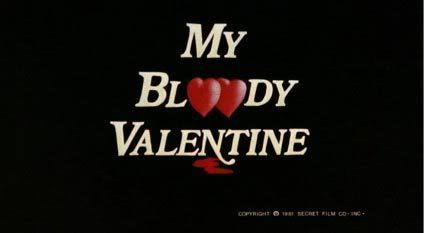 Awhile back a friend from my old job mentioned to me that she had recently rented the 1981 holiday slasher flick My Bloody Valentine and remarked that she had been surprised to find out that it was Canadian. Being the obnoxious geek that I am, I explained to her that it must have been one of the infamous "Tax-Shelter Films" from that period.
Awhile back a friend from my old job mentioned to me that she had recently rented the 1981 holiday slasher flick My Bloody Valentine and remarked that she had been surprised to find out that it was Canadian. Being the obnoxious geek that I am, I explained to her that it must have been one of the infamous "Tax-Shelter Films" from that period. But unlike most of the films from this strange period in Canadian cinema, My Bloody Valentine stands out because rather than deny its Northern origins, it embraces them almost to the point of unintended self-parody. Fearful of alienating American audiences, the majority of films shot in Canada (even to this day) are either set in specific American locales or in nameless, unidentified places where all hints of Canadiana are carefully kept away from the camera. This is definitely not the case with this film, though, as it could very well be THE MOST EXPLICITLY CANADIAN MOVIE EVER MADE. Seriously, the only way the movie could be more Canadian would be if the killer turned out to be a beaver in a hockey mask who killed his victims by stuffing Timbits down their throats. And in case any movie producers are reading this, THAT is a movie I would very much like to see.
But unlike most of the films from this strange period in Canadian cinema, My Bloody Valentine stands out because rather than deny its Northern origins, it embraces them almost to the point of unintended self-parody. Fearful of alienating American audiences, the majority of films shot in Canada (even to this day) are either set in specific American locales or in nameless, unidentified places where all hints of Canadiana are carefully kept away from the camera. This is definitely not the case with this film, though, as it could very well be THE MOST EXPLICITLY CANADIAN MOVIE EVER MADE. Seriously, the only way the movie could be more Canadian would be if the killer turned out to be a beaver in a hockey mask who killed his victims by stuffing Timbits down their throats. And in case any movie producers are reading this, THAT is a movie I would very much like to see.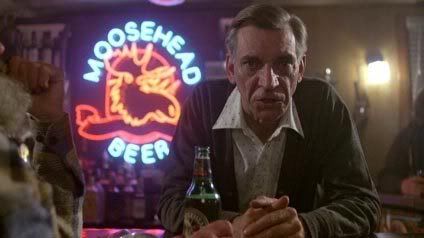 From the general hoser behaviour of its characters, the maple syrup thick Canadian accents (I swear I actually heard several examples of the fabled "a-boot"), the constant references to Moosehead Beer and a cast filled with familar Canadian actors (including Don "The Voice of Mok" Francks and Cynthia "Not Quite As Hot As Her Sister Jennifer" Dale) My Bloody Valentine isn't afraid to wear its country of origin on its sleeve, even though it does avoid mentioning it specifically. In fact this aspect of the movie is so strong, it's difficult for me to judge it in terms of a general audience. Frequently I found myself so enthralled by the blatent Canuckness of it all, that it never occurred to me whether or not a non-Canadian might find it as amusing as I did. I admit that to the eyes of a foreigner, My Bloody Valentine could be just another lame slasher movie with some odd accents and a cast of smalltown characters who strangely never talk about football. I, however, loved every minute of it.
From the general hoser behaviour of its characters, the maple syrup thick Canadian accents (I swear I actually heard several examples of the fabled "a-boot"), the constant references to Moosehead Beer and a cast filled with familar Canadian actors (including Don "The Voice of Mok" Francks and Cynthia "Not Quite As Hot As Her Sister Jennifer" Dale) My Bloody Valentine isn't afraid to wear its country of origin on its sleeve, even though it does avoid mentioning it specifically. In fact this aspect of the movie is so strong, it's difficult for me to judge it in terms of a general audience. Frequently I found myself so enthralled by the blatent Canuckness of it all, that it never occurred to me whether or not a non-Canadian might find it as amusing as I did. I admit that to the eyes of a foreigner, My Bloody Valentine could be just another lame slasher movie with some odd accents and a cast of smalltown characters who strangely never talk about football. I, however, loved every minute of it.
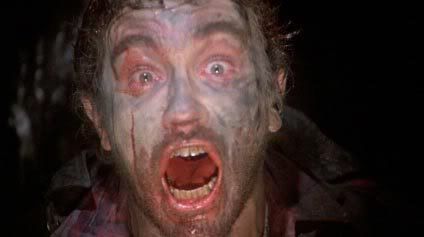 As the film's requisite Creepy Old Man tells the skeptical young miners who hang out in his bar, there's a reason why the town hasn't held a Valentine's Day dance in 20 years. It all began when two foreman--eager to leave work so they could get cleaned up and go to the dance--left six miners alone in the mine, all of whom were trapped when a methane leak caused an explosion. It took six weeks to clean up the rubble and only one of the six miners was found alive. Harry Warden, having lost his mind during the ordeal, resorted to cannibalism to survive and was more than a little pissed at the two foreman who left him and his friends alone in the mine that Valentine's Day. Wearing his workclothes, he killed the two men with a pick-ax befor being caught and sent to the nearby mental hospital. Since then all of the town's Valentine's festivities had been canceled, out of fear Harry might escape and return to mete out further vengeance against the town. But after two decades the story of the killer miner has become the stuff of boogeyman legend and everyone assumes it is safe to start celebrating the holiday of love once again. It goes without saying that they are mistaken.
As the film's requisite Creepy Old Man tells the skeptical young miners who hang out in his bar, there's a reason why the town hasn't held a Valentine's Day dance in 20 years. It all began when two foreman--eager to leave work so they could get cleaned up and go to the dance--left six miners alone in the mine, all of whom were trapped when a methane leak caused an explosion. It took six weeks to clean up the rubble and only one of the six miners was found alive. Harry Warden, having lost his mind during the ordeal, resorted to cannibalism to survive and was more than a little pissed at the two foreman who left him and his friends alone in the mine that Valentine's Day. Wearing his workclothes, he killed the two men with a pick-ax befor being caught and sent to the nearby mental hospital. Since then all of the town's Valentine's festivities had been canceled, out of fear Harry might escape and return to mete out further vengeance against the town. But after two decades the story of the killer miner has become the stuff of boogeyman legend and everyone assumes it is safe to start celebrating the holiday of love once again. It goes without saying that they are mistaken.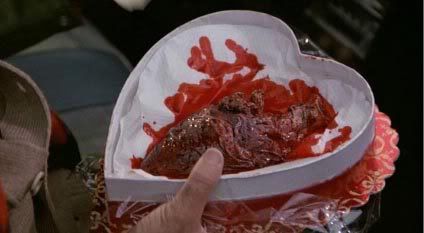 Given the nature of the holiday the movie is centered around, it's only natural that a part of its plot is devoted to a love triangle. T.J., the film's nominal hero (if only because he manages to survive all the way to the end) is the mayor's son who has returned to the town after failing to make it on his own "out west." During his absence he left behind Sarah (who also survives, but can't accurately be described as a proper Final Girl) who--never knowing if or when T.J. was going to return--started dating Axel. Sarah is clearly torn between the man who left her and now wants her back and the man who's been with her ever since T.J. went away, while the audience has trouble figuring out why she's attracted to either of them. I suspect many folks will find these more dramatic sequences difficult to sit through, but I found myself much taken by the low-rent CBC-ness of it all. It doesn't hurt that in the final scenes T.J. wears an open shirt, neck-bandana ensemble that is hilariously mesmerizing to behold.
Given the nature of the holiday the movie is centered around, it's only natural that a part of its plot is devoted to a love triangle. T.J., the film's nominal hero (if only because he manages to survive all the way to the end) is the mayor's son who has returned to the town after failing to make it on his own "out west." During his absence he left behind Sarah (who also survives, but can't accurately be described as a proper Final Girl) who--never knowing if or when T.J. was going to return--started dating Axel. Sarah is clearly torn between the man who left her and now wants her back and the man who's been with her ever since T.J. went away, while the audience has trouble figuring out why she's attracted to either of them. I suspect many folks will find these more dramatic sequences difficult to sit through, but I found myself much taken by the low-rent CBC-ness of it all. It doesn't hurt that in the final scenes T.J. wears an open shirt, neck-bandana ensemble that is hilariously mesmerizing to behold. Beyond that the film features the standard authority figures trying to keep the return of the murdering maniac a secret, the young adults defying the authority figures and throwing the party anyway and the shocking discovery that the killer isn't who everyone thinks it is. The gore is kept to a minimum and the filmmakers show an unfortunate restraint in their presentation of sex and nudity. Unlike most slasher movie victims, who at least get to enjoy penetration and/or a climax before they are killed, all of the amorous folks in this movie get whacked before they can even get past second base. And those folks who actually expect a movie like this to be frightening (which I've never really understood, but anyway...) will likely be disappointed as director George Milhalka keeps the action as predictable and suspense-free as possible. Despite this, anyone interested in seeing a completely straight-faced version of Strange Brew should definitely make every attempt to check out My Bloody Valentine
Beyond that the film features the standard authority figures trying to keep the return of the murdering maniac a secret, the young adults defying the authority figures and throwing the party anyway and the shocking discovery that the killer isn't who everyone thinks it is. The gore is kept to a minimum and the filmmakers show an unfortunate restraint in their presentation of sex and nudity. Unlike most slasher movie victims, who at least get to enjoy penetration and/or a climax before they are killed, all of the amorous folks in this movie get whacked before they can even get past second base. And those folks who actually expect a movie like this to be frightening (which I've never really understood, but anyway...) will likely be disappointed as director George Milhalka keeps the action as predictable and suspense-free as possible. Despite this, anyone interested in seeing a completely straight-faced version of Strange Brew should definitely make every attempt to check out My Bloody Valentine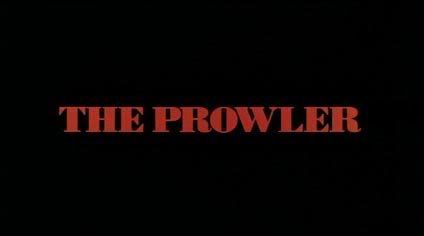 Also released as Rosemary's Killer in Europe, The Prowler is best remembered today for featuring some of Tom Savini's more memorable slasher movie make-up effects and for being the film that got director Joseph Zito the job of putting together the
Also released as Rosemary's Killer in Europe, The Prowler is best remembered today for featuring some of Tom Savini's more memorable slasher movie make-up effects and for being the film that got director Joseph Zito the job of putting together the 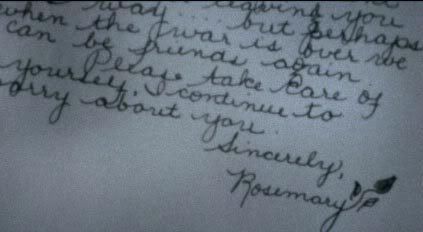
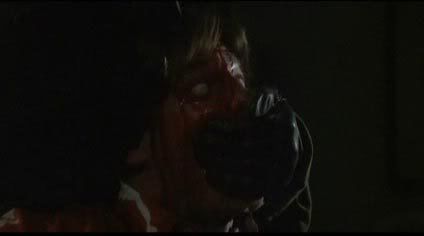 For reasons that are left to the audience's imaginations rather than actually explained, the never-caught psycho ex-soldier responsible for the murders that night 35 years earlier decides to suit up once again and arm himself with a bayonet, a sawed-off shotgun and his trusty pitchfork. He then proceeds to make his way to the almost-vacant dorm rooms and finds a young couple who are just about to get squishy with it. The young man gets a bayonet in the head and his naked girlfriend gets pitchforked in the shower.
For reasons that are left to the audience's imaginations rather than actually explained, the never-caught psycho ex-soldier responsible for the murders that night 35 years earlier decides to suit up once again and arm himself with a bayonet, a sawed-off shotgun and his trusty pitchfork. He then proceeds to make his way to the almost-vacant dorm rooms and finds a young couple who are just about to get squishy with it. The young man gets a bayonet in the head and his naked girlfriend gets pitchforked in the shower. 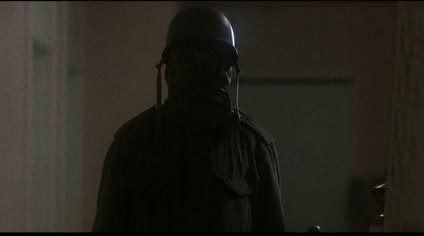
 From that point on the movie does what its supposed to do and intercuts scenes of The Prowler killing folks with Pam and Mark trying to figure out what is going on. The script does try to be a bit different by ignoring some of the more blatent cliches. For example one couple (who ultimately serve absolutely no purpose to the film's narrative) are allowed to have sex without dying and the male protagonist is allowed to remain alive. But even here the picture is a bit clumsy, since we are lead to believe The Prowler has killed Mark, but he is shown to be alive and unharmed after Pam finally manages to kill the murderer in typical Final Girl fashion. This could have been cleared up with a single line of dialogue, but the filmmakers seem too eager to get to the film's last shocking surprise (which ends up being neither shocking or surprising) to bother tying up such an obvious loose end.
From that point on the movie does what its supposed to do and intercuts scenes of The Prowler killing folks with Pam and Mark trying to figure out what is going on. The script does try to be a bit different by ignoring some of the more blatent cliches. For example one couple (who ultimately serve absolutely no purpose to the film's narrative) are allowed to have sex without dying and the male protagonist is allowed to remain alive. But even here the picture is a bit clumsy, since we are lead to believe The Prowler has killed Mark, but he is shown to be alive and unharmed after Pam finally manages to kill the murderer in typical Final Girl fashion. This could have been cleared up with a single line of dialogue, but the filmmakers seem too eager to get to the film's last shocking surprise (which ends up being neither shocking or surprising) to bother tying up such an obvious loose end.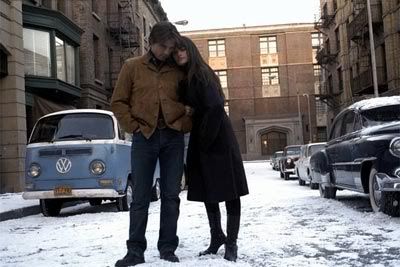
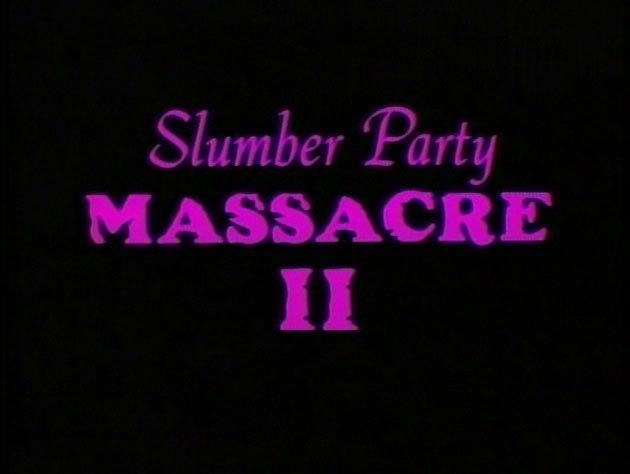





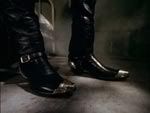


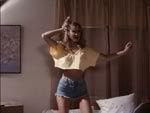
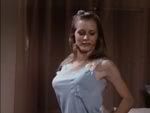




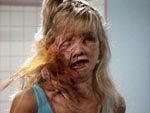
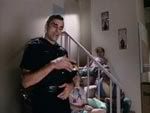
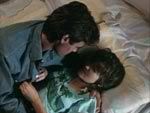
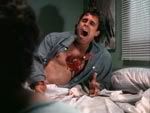
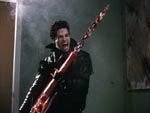
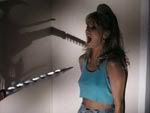
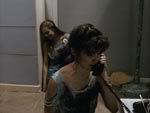
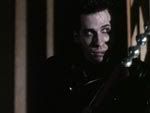

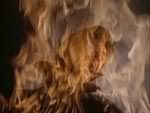
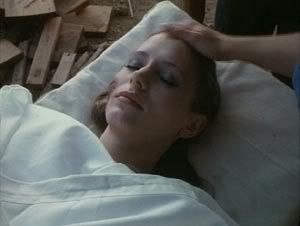
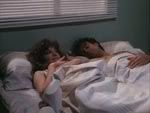
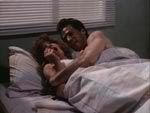
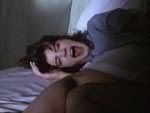
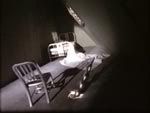
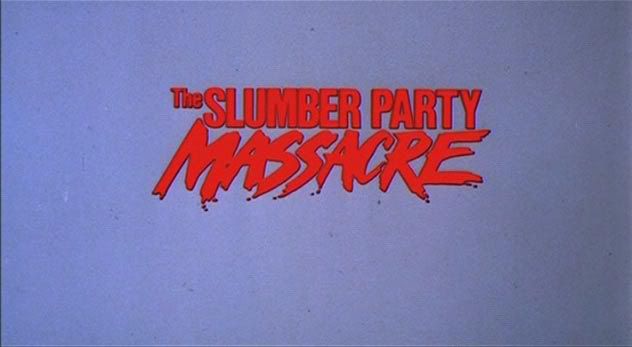
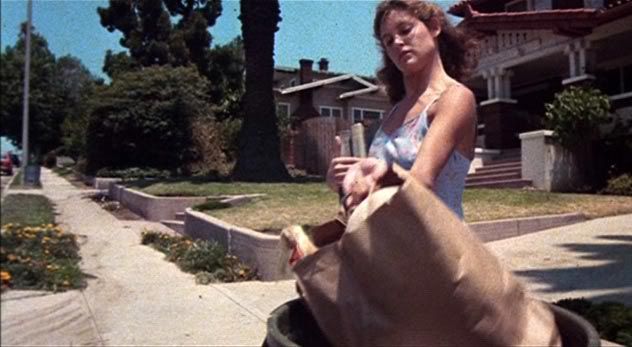

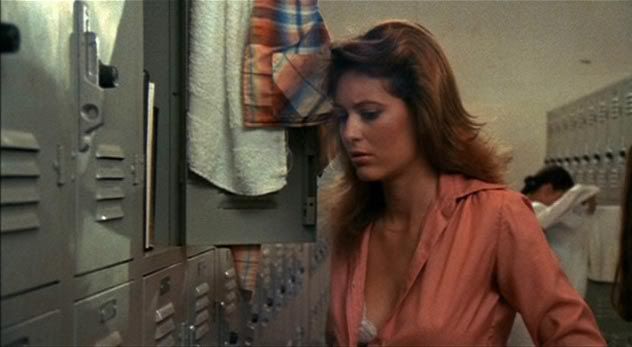


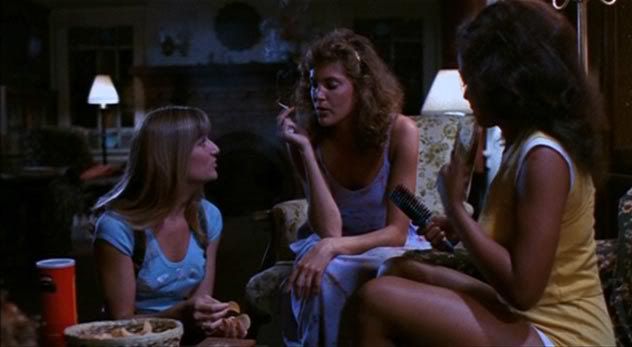


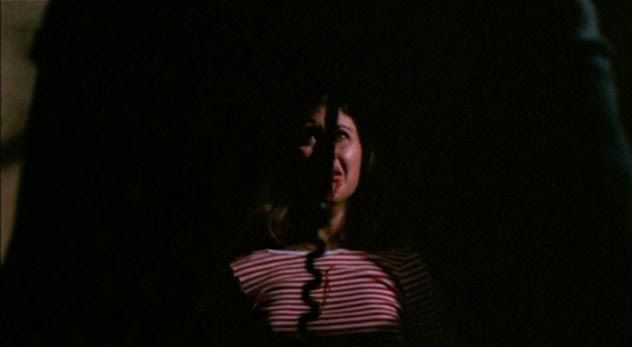
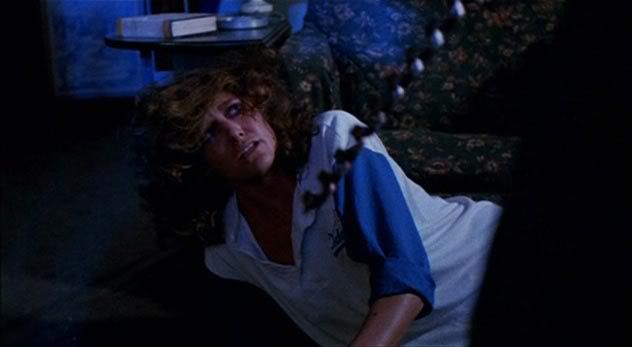

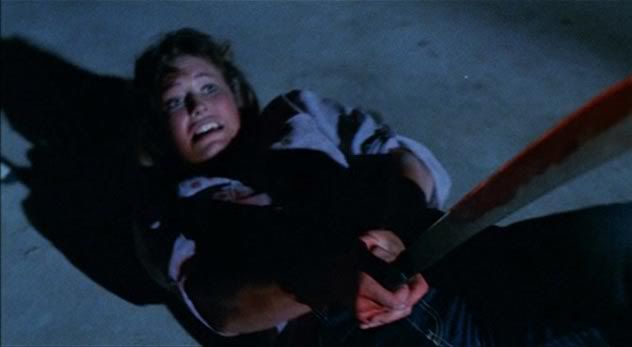










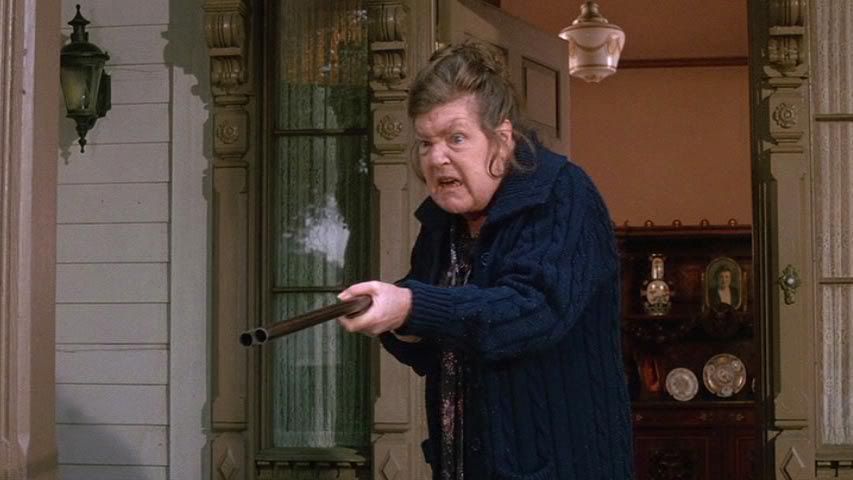


















































































































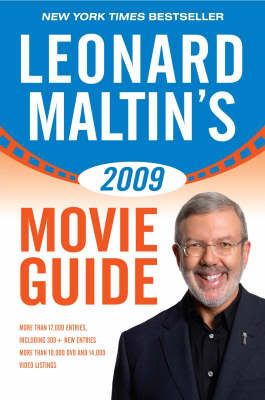 In a
In a 